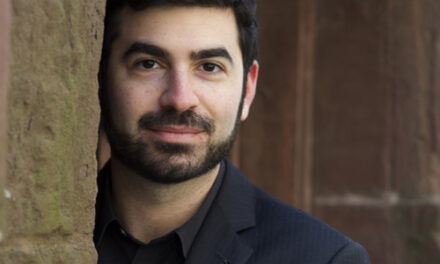The Wilmington Symphony Orchestra, performing in the Wilson Center – Wilmington’s superb large performance hall – took on the role of accompanist to the delightful and affecting play Beethoven Lives Upstairs. This award-winning story started life in 1989 as a children’s audio cassette recording (do some of our readers remember those?) by Barbara Nichol. It was released as a film in 1992 – since then seen in numerous countries and languages – and the next year won the Primetime Emmy Award for Outstanding Children’s Program. By now, it might be called a children’s classic, but one that is engaging to viewers of all ages. This viewer thoroughly enjoyed the performance.
The story begins in Vienna on the day Beethoven died (March 1827) and then unfolds retrospectively beginning a number of years before that. When we meet him, young Christoph is unhappy that his mother has rented their upstairs room to the irascible, temperamental Beethoven, whom the neighborhood kids think is mad. In an epistolary exchange with his uncle who is far away in Berlin, we follow the unfolding of a growing sense of empathy of the young boy for the afflicted master composer. Christoph is in attendance at the now-legendary premiere of Beethoven’s 9th Symphony (May 1824), and by then he felt that the two had a genuine connection. Beethoven at some point moves out, and the story ends where it began, on the day Beethoven died. Christoph, older now, has his memories, and the audience has witnessed some of the drama of Beethoven’s life and music through this touching (fictional) relationship. Along the way, one hears excerpts from about two dozen Beethoven works, including some of his most famous, likely to make many in the audience sit up and inwardly exclaim, “I recognize that!”
Christoph was played by Andrew Redlawsk, and his sympathetic uncle, already a lover of Beethoven’s music, by Thad Avery. Both were excellent. They inhabited their characters and played off each other well. The handing off of the narrative between them – the kind of transitions which can pose technical challenges – were well done and always kept the storyline and the dialogue smooth. The shifting moods, especially of Christoph, who had a lot to react to, were effective.
The simple black capes in which the characters started and ended the story effectively evoked the time period. Lighting repeatedly showed the changing moods. The sheets of paper used as props were especially well deployed as they were launched all over during the storm. Rather surprisingly, not one ended up being carried into the audience on some sort of air current.
The music served as an ongoing backdrop to the story and often helped illustrate the shifting events. Starting the story at Beethoven’s death was the dirge-like second movement of the 7th Symphony. In the comparable position at the end were soothing sounds from the 6th (“Pastoral”) Symphony. A Beethoven tantrum was dramatized by the aptly named piano piece, “Rage over the Lost Penny.” The 9th Symphony was played as the premiere of the piece took place in the story. The ultra-famous first movement of the 5th Symphony was, strategically, the second piece heard, probably so that everyone in the audience would connect with a sense of familiarity right at the beginning.
As something of a narrative element, the orchestra was not meant to be front and center. They were positioned fairly far back on the stage, so as to allow the action to unfold in the front. That dampened the acoustics. The music was often being heard behind the amplified voices, and one felt that at times that tempos were affected by the need to synchronize with the dialogue.
All that said, generally, the music was well played. There were less successful moments, such as the repeatedly imprecise attacks in the 5th Symphony excerpt. There were effective places as well, such as the gentle ending from the 6th Symphony. Luis Barragán was the versatile pianist heard in about a dozen excerpts – solo, chamber, and concerto. He could be sloppy at times, such as in the “Rage Over the Lost Penny” excerpt. On the other hand, his portion of the uber-famous Moonlight Sonata was beautifully atmospheric.
One could imagine Beethoven Lives Upstairs to have a popularizing effect for Beethoven like the movie Amadeus had for Mozart – though Beethoven may need less familiarizing. Both composers spent important years of their careers in Vienna, and the movies have in common that they were filmed in Prague. The beautiful old city there was not bombed during WWII, and it preserves an atmosphere much like Vienna would have had in Beethoven’s time. No attempt was made in the play to recreate that visual scene on stage. Nor was it needed. The drama and the music spoke very well for themselves. The enthusiastic response from the audience – and the large number of kids in attendance – suggested that the relatable emotions and the surpassing music still speak to new generations and continue to engage their parents and grandparents. Advocacy like this is just what our great composers need.











